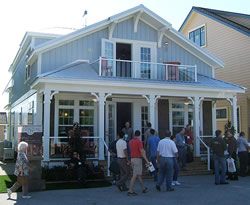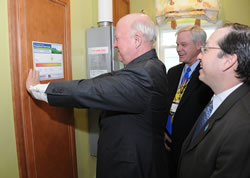
|
|
April 2008 |
FSEC-Partnered Project Wows at International Builders Show In February, the National Association of Home Builders (NAHB) held their annual International Builders Show at the Orange County Convention Center for the fourth year in a row. This year 92,000 builders, construction professionals and buyers attended, and the high-performance homes stole the show again. Some of these homes, with their energy-saving construction and features, were designed and evaluated with the help of many Florida Solar Energy Center (FSEC) faculty. As part of FSEC’s Building America Industrialized Housing Partnership (BAIHP), researchers provided in-depth technical assistance to the builders of these highly visible homes to assure significant levels of energy efficiency. FSEC researchers also attended the show in Orlando to provide live technical help at the U.S. Department of Energy’s (DOE) “Ask the Experts” booth and educate visitors about the technologies being supported by energy efficiency and solar energy research. “One of the great things about being part of the show is meeting the variety of people who are interested in high performance and energy-efficient construction, as well as providing answers to their challenging questions,” said Stephanie Thomas-Rees, a research architect in FSEC’s Buildings Research Division who was stationed at the DOE booth. In addition to Thomas-Rees, FSEC employees David Hoak, Danny Parker, John Sherwin, Camilo Gil, David Beal, David Chasar, Bob Abernethy, Janet McIlvaine and Subrato Chandra had a chance to provide expertise at the booth during the four-day show. While at the booth, Chandra, BAIHP project director, had the opportunity to brief DOE Secretary Samuel W. Bodman and Assistant Secretary Andrew Karsner on the Building America program. This year, two homes built by Palm Harbor Homes with help from FSEC were on display at the show: the Bimini II “Green” home and the Glen Cairn “Comfortably Affordable” home. As part of the BAIHP project, personnel from FSEC and Calcs-Plus, a BAIHP subcontractor, worked with Palm Harbor Homes by conducting blower door testing for leakage, performing factory and site inspections, attending design review meetings and making recommendations to assure energy efficiency and sustainable design. Both homes were outfitted with low-E, double glazed vinyl windows, spray foam insulation, high-efficiency heat pumps, Energy Star® appliances, and a number of other features to promote energy efficiency and indoor air quality. The Bimini model also featured a solar water heater donated by the SunBuilt program. For the first time in the history of the Builders' Show, one of the four days was designated “Green Day” to celebrate the green sector of the building industry. In conjunction with this all-day green celebration, DOE announced its Builders Challenge, which called on the U.S. homebuilding industry to build at least 220,000 high-performance, energy-efficient homes by 2012. The scale on which DOE ranks all homes participating in the Builders Challenge is the EnergySmart Home scale, or E-scale, where home ratings are based on their overall energy performance. A typical new home today might score 100 on this scale, while zero-energy homes score a zero because they produce as much energy as they consume. For a home to qualify for the Builders Challenge, it must score 70 or lower. This score would essentially translate to a 30 percent more energy-efficient home than the average new home built to current international energy efficiency codes. Almost half of the 38 builders that signed up for the Challenge on February 14 are working with FSEC’s BAIHP team. “There was an increased interest at the DOE booth this year,” said Janet McIlvaine, an FSEC buildings research analyst. “I think the announcement of the Builders Challenge sparked a lot of interest in green building and energy efficiency at this year’s show.” The first E-scale label was placed in the Bimini model home, boasting its Builders Challenge qualifying score of 57, by DOE Secretary Bodman with the help of Assistant Secretary Karsner and Philip Fairey, FSEC Deputy Director. FSEC also created several “green tags” that were placed in the home which highlighted specific green products showcased inside the home. The FSEC team produced the E-scale labels and informational brochures highlighting energy-efficient and sustainable energy strategies used in the construction of the home, as well as the Florida Green Building Coalition certifications for both the Bimini and Glen Cairn models. FSEC personnel leading this effort were Stephanie Thomas-Rees, David Hoak, Sherri Shields and Anne Marie Anderson. Dennis Stroer of Calcs-Plus, and a member of the BAIHP team, conducted the testing and energy rating support for both of the Palm Harbor homes. “There was a huge amount of involvement from FSEC, our partners and subcontractors that led toward the success of these show homes,” said Thomas-Rees. “This year we [FSEC] probably had the heaviest employee participation in the show ever.” FSEC employees were involved in a number of activities surrounding high-profile, site-built show homes as well. Carlos Colon, senior buildings research engineer, led the energy testing and rating for the New American Home 2008 in Lake Nona, while Thomas-Rees led the green certifications. David Hoak, a buildings researcher, provided photo documentation of construction, inspections, and testing support for the home. The New American Home is an annual building program that demonstrates use of innovative building materials, cutting-edge design, and the latest construction techniques, providing production homebuilders with an example for producing more energy-efficient, durable homes without sacrificing style. Eric Martin and John Sherwin, both senior buildings research engineers, worked with Calcs-Plus personnel to provide technical expertise and green certifications for the 2008 Orlando Vision House. The Green Builder Vision House Series is a group of demonstration projects around the country that showcase design in accordance with the NAHB’s Model Green Building Guidelines, which address lot preparation and design, resource efficiency, energy efficiency, water efficiency and conservation, occupancy comfort and indoor environmental quality, and operation, maintenance, education and global impact. This year, the 2008 Orlando Vision House was certified green according to a statewide green building program operated by the Florida Green Building Coalition. “So much interest in energy efficient building was generated at this year’s show,” said Thomas-Rees. “I’m confident that green building will continue to become a more common practice in the upcoming years.” View the case studies for more details. |


